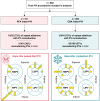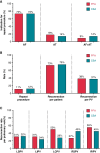Pulsed-field- vs. cryoballoon-based pulmonary vein isolation: lessons from repeat procedures
- PMID: 39166530
- PMCID: PMC11363872
- DOI: 10.1093/europace/euae221
Pulsed-field- vs. cryoballoon-based pulmonary vein isolation: lessons from repeat procedures
Abstract
Aims: Pulsed-field ablation (PFA) is an emerging technology to perform pulmonary vein isolation (PVI). Initial data demonstrated high safety and efficacy. Data on long-term PVI durability and reconduction patterns in comparison to established energy sources for PVI are scarce. We compare findings in repeat ablation procedures after a first PFA to findings in repeat ablation procedures after a first cryoballoon ablation (CBA) based PVI.
Methods and result: A total of 550 consecutively enrolled patients underwent PFA or CBA index PVI. Repeat ablations in patients with symptomatic atrial arrhythmia recurrences were analysed. A total of 22/191 (12%) patients after index PFA-PVI and 44/359 (12%) after CBA-PVI underwent repeat ablation. Reconduction of any pulmonary vein (PV) was detected by multipolar spiral mapping catheter at each PV with careful evaluation of PV potentials and by 3D-mapping in 16/22 patients (73%) after PFA-PVI and in 33/44 (75%) after CBA-PVI (P = 1.000). Of 82 initially isolated PVs after PFA-PVI, 31 (38%) were reconducting; of 169 isolated PVs after CBA-PVI, 63 (37%) were reconducting (P = 0.936). Clinical atrial tachycardia occurred similarly in patients after PFA (5/22; 23%) and CBA (7/44; 16%; P = 0.515). Roof lines were set more often after PFA- (8/22; 36%) compared with CBA-PVI (5/44; 11%; P = 0.023). Repeat procedure duration [PFA: 87 (76, 123) min; CBA: 93 (75, 128) min; P = 0.446] was similar and fluoroscopy time [PFA: 11 (9, 14) min; CBA: 11 (8, 14) min; P = 0.739] equal between groups at repeat ablation.
Conclusion: During repeat ablation after previous PFA- or CBA-based PVI, electrical PV-reconduction rates and patterns were similar.
Keywords: Atrial fibrillation; Atrial tachycardia; Cryoballoon; Pulmonary vein isolation; Pulsed-field ablation; Reconduction; Reisolation; Repeat ablation.
© The Author(s) 2024. Published by Oxford University Press on behalf of the European Society of Cardiology.
Conflict of interest statement
Conflict of interest: none declared.
Figures





References
-
- Tzeis S, Gerstenfeld EP, Kalman J, Saad EB, Sepehri Shamloo A, Andrade JG et al. 2024 European Heart Rhythm Association/Heart Rhythm Society/Asia Pacific Heart Rhythm Society/Latin American Heart Rhythm Society expert consensus statement on catheter and surgical ablation of atrial fibrillation. Europace 2024;26:euae043. - PubMed
-
- Kirchhof P, Camm AJ, Goette A, Brandes A, Eckardt L, Elvan A et al. Early rhythm-control therapy in patients with atrial fibrillation. N Engl J Med 2020;383:1305–16. - PubMed
-
- Sohns C, Fox H, Marrouche NF, Crijns HJGM, Costard-Jaeckle A, Bergau L et al. Catheter ablation in end-stage heart failure with atrial fibrillation. N Engl J Med 2023;389:1380–9. - PubMed
-
- Avgil Tsadok M, Gagnon J, Joza J, Behlouli H, Verma A, Essebag V et al. Temporal trends and sex differences in pulmonary vein isolation for patients with atrial fibrillation. Heart Rhythm 2015;12:1979–86. - PubMed
-
- Joglar JA, Chung MK, Armbruster AL, Benjamin EJ, Chyou JY, Cronin EM et al. 2023 ACC/AHA/ACCP/HRS guideline for the diagnosis and management of atrial fibrillation: a report of the American College of Cardiology/American Heart Association joint committee on clinical practice guidelines. Circulation 2024;149:e1–156. - PMC - PubMed
Publication types
MeSH terms
Grants and funding
- Biosense Webster
- Farapulse
- Research Promotion Fund of the Faculty of Medicine
- Abbott
- German Heart Foundation
- University of Hamburg
- German Federal Ministry of Education and Research
- German Research Foundation
- European Union
- BHF_/British Heart Foundation/United Kingdom
- Leducq Foundation
- MRC_/Medical Research Council/United Kingdom
- German Centre for Cardiovascular Research
- 2015140571/University of Birmingham
- Biosense
- Medtronic
- St. Jude Medical
- Cardiofocus
- EP Solutions
- Ablamap
- EPD Solutions/Philips
- Novartis
- Boehringer Ingelheim
- Galaxy medical
- Lifetech
- Bayer
LinkOut - more resources
Full Text Sources
Medical
Research Materials

